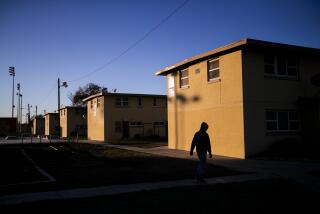Bursting at the Seams
One of the city’s oldest water pipelines runs along Canterbury Avenue in the northeast San Fernando Valley. When it was installed, William Mulholland was water superintendent, Los Angeles had a population of 450,000 and the aqueduct carrying Owens River water 223 miles from the eastern Sierra had just been built.
Today, this 84-year-old section of pipeline is part of 144 miles of old riveted steel pipes throughout the city that the Department of Water and Power plans to replace over the next 20 years, at a cost of $450 million. The DWP’s plan calls for 14 miles of pipeline to be replaced in the highest-risk areas in two years and an additional 36 miles in seven years. The Valley has about 44 miles of high-risk pipeline.
A burst water main in an Encino backyard on Oct. 16 led the DWP to accelerate the replacement project, which has been in the works for several years. The 36-inch-diameter pipe that burst was installed in 1921 and runs from the dam at Encino Reservoir--a main water source for that area of the Valley--to Ventura Boulevard.
As the work proceeds, the impact on residents should not be great. DWP officials said. “There should be no water outages with work on small pipes. Big lines will be backed up by other major trunk lines,” said DWP spokesman Marty Adams. “People will hardly notice, if they notice at all, that the pipe is being replaced.” Replacement techniques will vary according to the location and traffic. According to DWP project manager Julie Spacht, some work contracts have already been rewarded and “speed and efficiency” are the project goals.
Aging Water Pipes
The DWP has identified 65 miles of riveted steel trunk line more than 60 years old citywide, 44 miles of it in the Valley. Thirty-six miles citywide present the highest risk and head the list for repair or replacement.
Key:
Red: Riveted steel trunk line (planned to replacement within 10 years)
Blue: High-priority riveted steel trunk line (36 miles, planned for replacement within seven years)
1. Cantebury section: Installed in 1913
2. Roscoe section: Installed in 1913; sliplining repair will begin in January on the 5-mile stretch of 42-inch pipe.
3. DeSoto section: Installed in 1917.
Pipe Replacement
Some sections of pipe will be dug out and entirely replaced, while other sections will be “slip-lined,” a trench-less technique used mostly in heavily trafficked areas.
Slip-Lining involves lining existing pipe with a plastic pipe. A pit is dug about every 1,000 feet and plastic is pushed through the existing pipe.
Water Distribution System
More than 3,000 miles of the system’s 7,100 miles of pipes lie beneath the Valley, carrying water from the Los Angeles Aqueduct and other sources to reservoirs, holding tanks and homes across the city.
Los Angeles Aqueduct pipe is about 144 inches in diameter at the Los Angeles Aqueduct Filtration Plant in Sylmar.
Service line is a 1-inch-diameter pipe that feeds into house
Distribution main connects trunk line to meters and smaller service connections.
Trunk line, measuring 36 to 72 inches, is a large-capacity, non-interconnecting pipe, carrying water from reservoir to major areas. Nearly 50% of the city’s 300 miles of trunk lines were installed before 1940.
Source: Department of Water and Power; Researched by JULIE SHEER / Los Angeles Times
More to Read
Sign up for Essential California
The most important California stories and recommendations in your inbox every morning.
You may occasionally receive promotional content from the Los Angeles Times.









